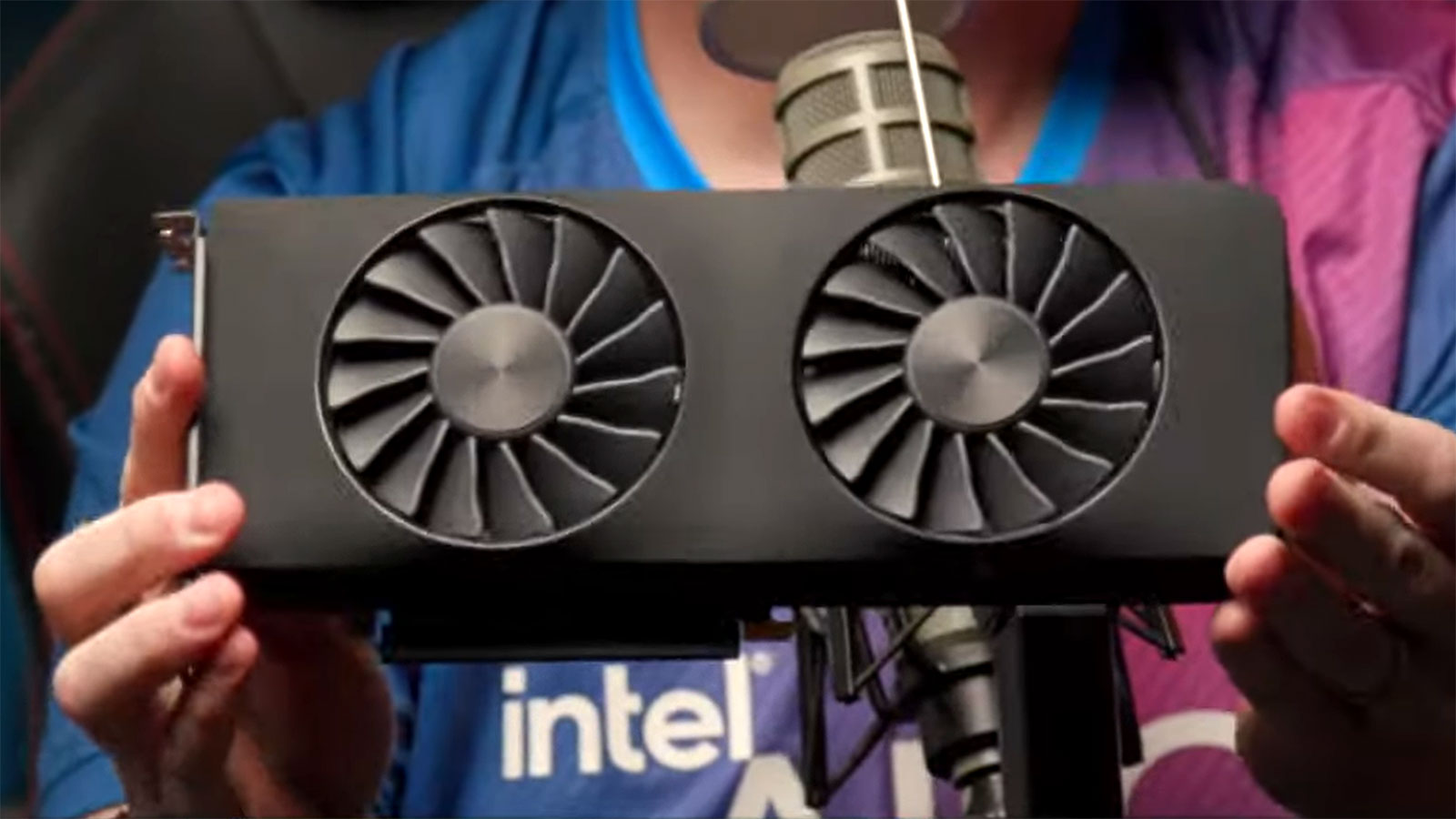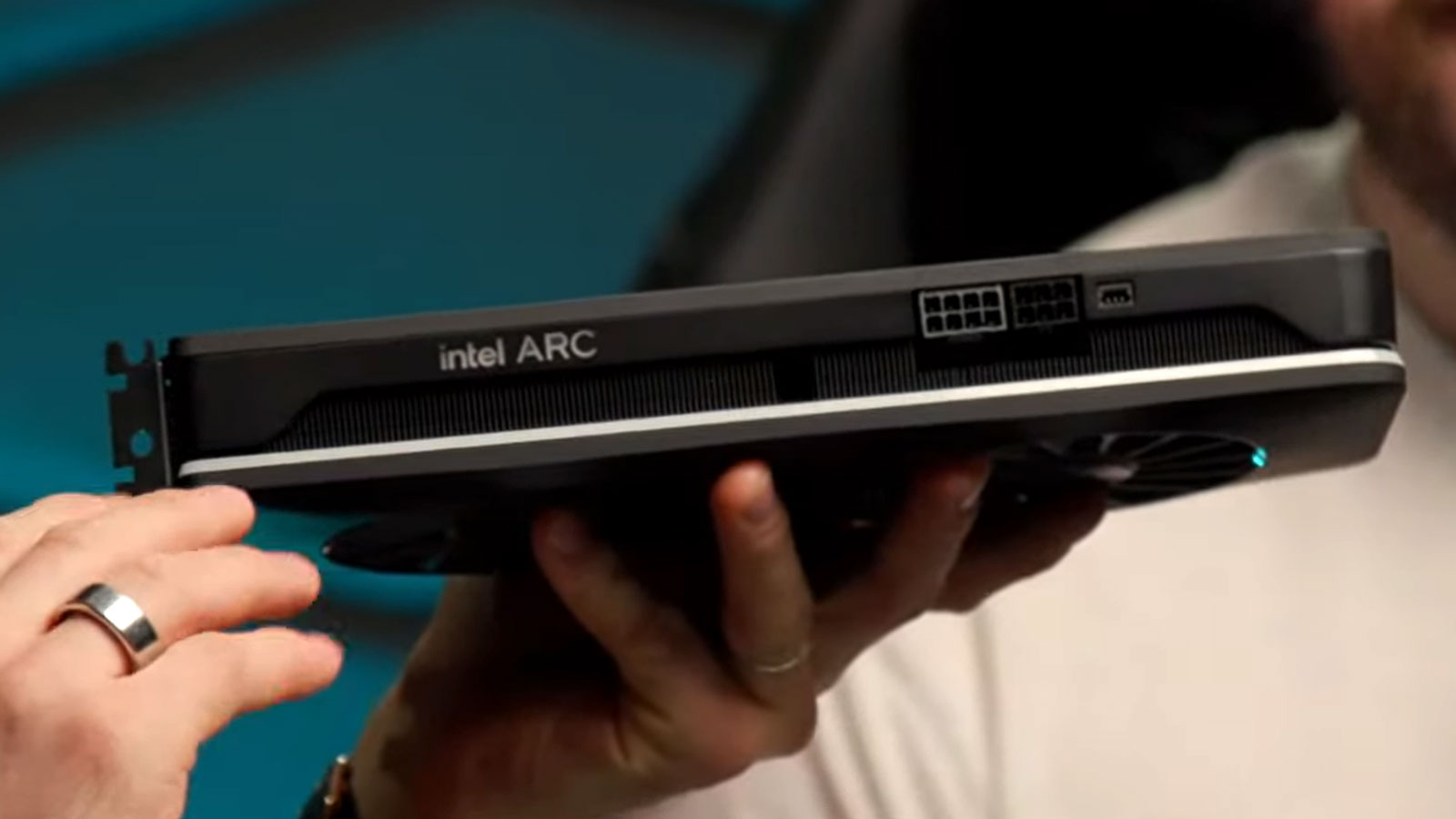Intel Showcases Arc A770 Limited Edition GPU In A Few Games
Intel Graphics execs were guests on The WAN Show on Friday and had an exceptional product to showcase in front of the cameras for the first time. The Intel Arc A770 Limited Edition graphics card is unboxed, handed around, and rotated through all angles. But that isn't all, the Intel PR folk discussed some technical details of this previously unrevealed graphics card, and there was some chat about gaming performance with the hosts.
The design of the A770 featured in the video has a lot in common with the Intel Arc A750, which we saw featured in an official performance preview yesterday. It has a similar-looking twin axial fan cooled shroud. However, befitting a reference model for the flagship Intel Arc Alchemist GPU, there are many more RGB lighting zones/effects, including the backlit logo on the top of the card and a diffused RGB light bar along the top/fan-side edge. In addition, slightly recessed behind the twin axial fans are diffused RGB light rings. Finally, a swash of RGB lighting is also visible on the backplate.
There was some interesting talk about the performance of the Arc A770. We didn't see any performance figures for the A770, but we heard that Tom Peterson (AKA TAP) from Intel demonstrated gaming in titles like Cyberpunk 2077, F1 2021, and Shadow of the Tomb Raider. It sounded like Linus had some gaming time on this setup, but we didn't get any performance stats. TAP cleared up the secretive nature of the demo by explaining that the demoed card isn't sampling with devs/partners yet, and the demo was more of a sneak peek.
Intel shared the Arc A750 gaming performance numbers yesterday if you want to do your extrapolation and guesstimation of Arc A770's performance. The A770 offers 25% more GPU cores, VRAM, and a wider memory bus. Unfortunately, no one talks about other GPU features, like raytracing or AI acceleration.
While we didn't get performance numbers from the Arc A770, TAP blurted out quite a revealing statement about the performance users can expect from the Alchemist flagship. "This is the first card that I have seen from Intel, that I go 'You know what? It's all going to be OK," said the ex Nvidia, now Intel exec, adding, "we nailed it."



The performance sounds decent, but the warmness of our welcome will depend on the price, of course. On the topic of warmth, TAP asserted that the Arc A770 has a dual axial cooler that is over-spec, so it should easily quietly keep the GPU cool. The GPU temperature peaked at 69 degrees Celsius under load when gaming with Linus. TAP later added that power consumption was “very tame.” Given that cooling and power consumption combination, there is “pretty good” overclocking potential.
On the software driver side and supporting Adaptive Sync, Intel said that the new Arc Alchemist would support a game experience enhancing feature called Smooth Sync. Unfortunately, we didn’t get an in-depth explanation of Smooth Sync, but it appears to work on any monitor, eliminating tearing using a temporal algorithm.
Get Tom's Hardware's best news and in-depth reviews, straight to your inbox.
Intel didn’t share the pricing, specific performance claims, or availability dates regarding the Intel Arc A770. Nevertheless, TAP teased that availability for this flagship Arc Alchemist GPU will come out “before you know it.”
For more information on Intel Arc, please check out the recent Arc A750 performance preview and our regularly updated Intel Arc all-we-know information compilation. As things stand, it looks like the Intel Arc A770 has a good shot of winning a place in our best graphics cards roundup after reviewing it.

Mark Tyson is a news editor at Tom's Hardware. He enjoys covering the full breadth of PC tech; from business and semiconductor design to products approaching the edge of reason.
-
jp7189 "isn't sampling with Devs/Partners yet"Reply
What does this mean for timeline? Doesn't that usually happen months before retail release? -
InvalidError Smooth Sync is basically just blending the boundary where the frame buffer switches over. GN had a few screenshots of it in action, basically looks like there is dither-blending across the seams (pulling some pixels from the new frame into the old frame a few lines before the frame buffer swap, then blending old pixels into the new fame for a few more lines after) to make them less jarring.Reply
